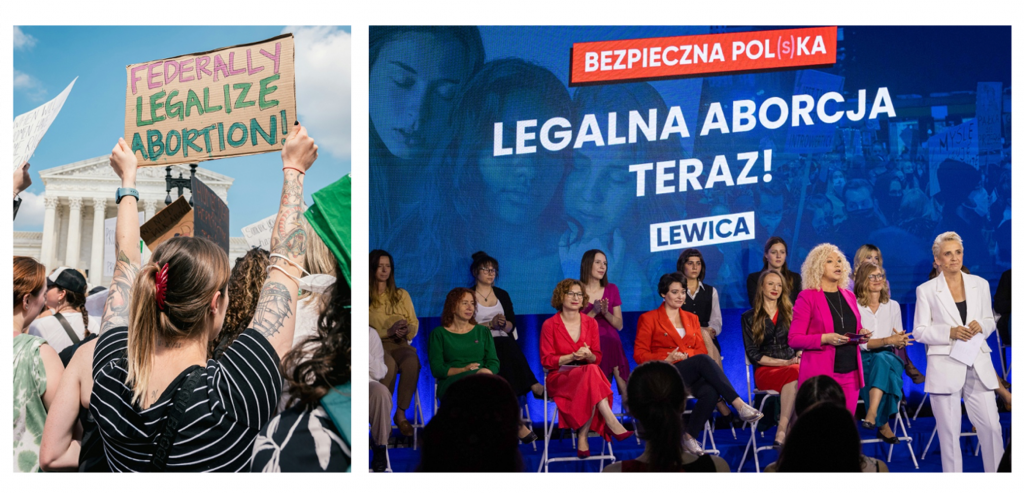
Abortion and Elections: Social Resistance to Abortion Bans in the US and Poland
Daniel J. Schulte
Trump faces several hurdles in his 2024 White House bid; in addition to numerous court cases, his position on abortion bans threatens to mobilize oppositional activists and voters. On April 8, Trump stated, “I was proudly the person responsible for ending…Roe v. Wade” (Trump, 2024a). The next day, however, the Arizona Supreme Court controversially brought back an 1864-era state law that bans all abortions except in the case of risk to the mother’s life; the court’s decision replaces the previous 15-week ban and imposes a two-to-five-year prison sentence on physicians caught administering abortions (Billeaud and Lee, 2024). Arizona’s ability to decide its own abortion policy is a consequence of the overturning of Roe v. Wade, for which Trump claims credit. However, this unpopular Arizona abortion ban may hurt Trump’s chances of winning. Accordingly, on April 12, Trump posted, “The Supreme Court in Arizona went too far on their Abortion Ruling, enacting and approving an inappropriate Law from 1864. So now the Governor and the Arizona Legislature must use heart, common sense, and act immediately, to remedy what has happened” (Trump, 2024b). Why did Trump clarify his stance on abortion? Could the abortion issue play a role in shaping the US election results?
Unsurprisingly, abortion is a polarizing issue involving moral and philosophical arguments about what is right and wrong. The abortion issue evokes strong emotions in both right and left voters. Restrictive abortion bans can especially mobilize women, independents, and younger voters who might worry about the erosion of women’s rights. On the other hand, Evangelicals and other conservative voters support strong abortion bans, and many supported Trump in 2016 due to his anti-abortion stance (Bleiker, 2020). Since abortion is so contentious, politicians often try to choose a position that garners enough votes without jeopardizing other votes. For this reason, leaders commonly clarify their position in line with public opinion. However, leaders don’t always know how the public will react.
Last autumn’s election in Poland provides an example where leaders learned after the fact that their abortion position was too unpopular to win. After eight years in government, the right-wing Law and Justice party narrowly lost their re-election bid; the highly unpopular abortion ban is one important reason out of several contributing factors (Sieradzka, 2023). Poland’s previous abortion policy—on the books since 1993—was already very restrictive and only allowed abortion in the case of exceptions including risk to the mother’s life, rape or incest, or fetal deformities(Grzymała-Busse, 2015). After all, Poland is a country where 71% of the population identifies as Roman Catholic (Tilles, 2023a). However, in 2020 Law and Justice party-appointed judges on the Constitutional Tribunal court voted to make the abortion policy even more restrictive by removing the fetal deformity exception (Ciobanu 2020). This court ruling provoked nation-wide protests (Tronina and Kazmierska, 2023). Tellingly, after losing the election, the former Law and Justice prime minister, Mateusz Morawiecki, stated, “The application to the Constitutional Tribunal in this case was a mistake” (Tilles, 2023b).
The former prime minister likely considered the court ruling a political “mistake” because voters mobilized on the issue to throw Law and Justice out of government. Indeed, the Law and Justice’s vote share of 35.4% in 2023 decreased eight percentage points from 43.6% in 2019 (Guerra and Casal Bertoa, 2023). Opposition parties such as the Third Way, the New Left, and the Civic Coalition all ran on more permissive abortion policy platforms (Tronina and Kazmierska, 2023) and gained votes at the expense of Law and Justice. Women voters and young voters were especially decisive in throwing Law and Justice out of power (Rainsford, 2023). Voter turnout of 74.4% in the 2023 election was the highest since the fall of communism and up by nearly 12% points over the 2019 election (Guerra and Casal Bertoa, 2023).
It is to be seen whether the Republican Party follows a trajectory like that of Law and Justice. You could argue, perhaps, that the Republicans already learned about the social resistance to the abortion bans in the November 2022 midterms; after all, some analysts attribute the lack of a “red wave” to the Dobbs v. Jackson Women’s Health Organization Supreme Court decision, which overturned federal protections for abortion access in June 2022 (Kann, Ebanks, Morrier & Alvarez 2024). Perhaps, Trump’s clarifying statement about the Arizona Supreme Court ruling is his attempt to strike a more “moderate” position. However, Trump’s ability to distance himself from Arizona’s abortion ban is limited by the fact that he has proudly branded himself as the “person responsible for overturning…Roe v. Wade” (Trump 2024a). Similarly, Law and Justice party leadership had a difficult time distancing themselves from the 2020 Constitutional Tribunal ruling that further tightened Poland’s abortion policy.
In both countries, the courts’ rulings on abortion (Dobbs in the US and the Constitutional Tribunal ruling in Poland) transformed the political environment. Prior to those court rulings, taking a strong rhetorical stance against abortion may have been a winning position for Republicans in 2016 and Law and Justice in 2015 and 2019. However, once these conservative parties succeeded in using the courts to restrict abortion legally further, they became targets for activists and opposition parties to mobilize voters against the guys who took away women’s rights.
In the upcoming 2024 US election, the abortion issue may likely play a disproportionate role in key “swing states.” Many “swing states” have abortion bans or restrictive abortion policies that might provide the impetus for campaigns and activists to mobilize voters to support more permissive women’s rights policies. Since the races are already so tight, the mobilization of even a small percentage of voters who would otherwise not vote could be enough to sway the results. Florida already has an abortion referendum scheduled for November, and Arizona and Nevada may follow suit with similar referendums (Mulvihill and Kruesi, 2024). Although the 2024 election outcome is uncertain, abortion policy is shaping up to be an important factor just as it was in the 2023 Polish election.
References
Billeaud, J, and M. Lee. 2024. “What to Know about Abortion in Arizona under the Near-total 1864 Ban,” https://apnews.com/article/arizona-abortion-ban-what-to-know-797a4bbbc738497fe2284d6870c5be24 . Accessed April 15, 2024.
Bleiker, C. 2020. “Evangelicals: Trump’s Anti-abortion Base,” https://www.dw.com/en/us-2020-election-abortion-evangelicals-donald-trump/a-55159590. Accessed April 16, 2024.
Ciobanu, C. 2020. “Constitutional Tribunal Ruling Makes Abortion Practically Illegal in Poland,” https://balkaninsight.com/2020/10/22/constitutional-tribunal-ruling-makes-abortion-practically-illegal-in-poland/. Accessed April 15, 2024.
Grzymała-Busse, A. 2015. Nations under God: How churches use moral authority to influence policy. Princeton: Princeton University Press.
Guerra, S, and F. Casal Bertoa. 2023. “What we Learned from the 2023 Polish Election,” https://blogs.lse.ac.uk/europpblog/2023/10/24/what-we-learned-from-the-2023-polish-election/. Accessed April 15, 2024.
Kann, C, Ebanks, D, Morrier, J, and R. Alvarez. 2024. “Persuadable Voters Decided the 2022 Midterm: Abortion Rights and Issues-based Frameworks for Studying Election Outcomes,” PLOS ONE 19(1): 1-23.
Mulvihill, G, and K. Kruesi. 2024. “Which states could have abortion on the ballot in 2024?,” https://apnews.com/article/abortion-ballot-amendment-ban-protection-states-2024-052ff9846f8416efb725240af22b92ec. Accessed April 15, 2024.
Rainsford, S. 2023. “Poland Elections: Women and Youth Force PiS from Power,” https://www.bbc.co.uk/news/world-europe-67156864. Accessed April 16, 2024.
Sieradzka, M. 2023. “Were Women Key to Voting out Poland’s Ruling Conservatives?,” https://www.dw.com/en/were-women-key-to-voting-out-polands-ruling-conservatives/a-67214867. Accessed April 15, 2024.
Tilles, D. 2023a. “Proportion of Catholics in Poland Falls to 71%, New Census Data Show,” https://notesfrompoland.com/2023/09/29/proportion-of-catholics-in-poland-falls-to-71-new-census-data-show/. Accessed April 15, 2024.
Tilles, D. 2023b. “Pushing for Abortion Ban was a “Mistake”, admits Polish Prime Minister,”https://notesfrompoland.com/2023/11/06/pushing-for-abortion-ban-was-a-mistake-admits-polish-prime-minister/. Accessed April 15, 2024.
Tronina, D, and K. Kazmierska. 2023. “Abortion Rights and Election Campaigns: the Case of Poland,” https://blogs.lse.ac.uk/gender/2023/10/11/abortion-rights-and-election-campaigns-the-case-of-poland/. Accessed April 16, 2024.
Trump, D. 2024a. “Address on Abortion,” https://truthsocial.com/@realDonaldTrump/112235238031827342. Accessed April 15, 2024.
Trump, D. 2024b. “Truth Social Post on Arizona Supreme Court Abortion Ruling,” https://truthsocial.com/@realDonaldTrump/posts/112259523897710004. Accessed April 15, 2024.
Bio
Dr. Daniel J. Schulte is an associate lecturer in the Department of Political Science, at University College London. His research interests include morality politics, authoritarianism, women’s rights, democratic backsliding, and methods.
For more about his research, you can find him on his website: https://danieljschulte.com/


0 Comments